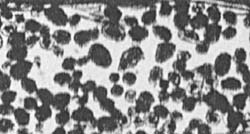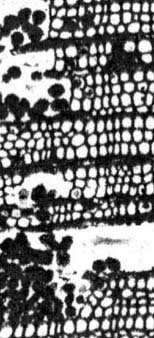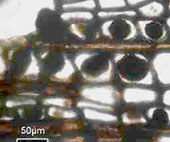Oribatid mite coprolites: Wishful
thinking in science
The
alleged sightings of oribatid mite coprolites in palaeozoic wood, once
a favourite subject of palaeobotanists worldwide,
seem to have become rarer
lately but still occur occasionally. It has been emphasized repeatedly
that such sightings are brought about by superficial observation, poor
judgement, and wishful thinking. One of
the latest sightings of this kind concerns angular clots in Permian
wood (Fig.1), presented as coprolites in [1].


Fig.1: Cell-size angular clots as they are occasionally seen in
silicified poorly preserved wood. Detail of Fig.13 in
[1], width of the picture 0.65mm.
Fig.2 (right): Cell-size angular clots in silicified wood with
spots of damage, also a few cells with dark fill
in intact tissue. Detail of Fig.15 in [1], width of the picture 0.4mm.
According
to common sense, clots appearing as polygonal sections on the cut plane
cannot be coprolites. It would not take vivid imagination to guess that
they had been moulded after the lumina of cells, all the more so since
virtually every petrified tree with clots shows some spot in the wood
where the relation
between clots and cells becomes obvious, as in Fig.2. A few clots
are seen within not yet decayed cells above right, and the arrangement
of the clots below left seems to be compatible with the tissue
structure. As a possible explanation based on various
observations, also on extant trees, the dark fill of some cells which
finally leads to the destruction of the cell walls may be a type of
wood rot [4]. There are a few cells in Fig.2 with small dark clots,
apparently in a state of growth, which do not yet fill the cell.
Against all evidence the authors [1] and others assume
that the damage to the wood as in Fig.2 had been done by gnawing
oribatid mites although no such creature has ever been seen preserved
together with the clots and the wood.

Fig.3: Permian wood from the same fossil site as those in Figs.1,2,
with cell-size angular clots in the
degraded half, arranged in deformed rows. Detail of Fig.17 in [2].
A tendency of lumps to stay there where they grew is indistinctly seen
in Fig.3. This picture shows four features of the
clots which make the coprolite interpretation seem absurd: cell-size
and angular, in slightly deranged rows, and the number of clots per
area roughly equalling the number of cells per area.
This may be sufficient fossil evidence to justify the statement
that to every
alleged oribatid mite coprolite there had
been a cell which produced it. This rule gets additional
support by clots orderly
placed in rows of cells,
as in Fig.4 and elsewhere.
Fig.4: Clots growing in one cell each,
having not yet filled the cell lumen. Detail from [3], Fig.4F, where
they are offered as coprolites.
The arguments contradicting the coprolite
interpretation are not new. They have repeatedly been presented to the
authors [1] since 2007. R.
Rößler replaced
"oribatid mites" by "unknown creatures" in 2010 [2] and by "new
detritivores" in 2012 [5] but revived the "oribatid mites" in 2014 [1].
Instead
of engaging in discussion based on fossil evidence, sticking to the
coprolites
in palaeozoic wood is defended by referring to others who did
the same. Those who have got into the same pitfall of misinterpretation
reassure themselves by mutual benevolent referring so that it is
virtually impossible to make them listen to arguments. In the present
case they keep to
the
two simple features which fit into their simple concept: dark
clots for coprolites, damage for boring galleries. They
dismiss all features
which do not fit in.
In the wood from the Crock fossil site (as well as
in other fossil wood) there are cavities so narrow that no mite could
have crept through but those are not mentioned in [1].
Every cavity made
by mites should have an exit tunnel through which the mites had escaped
before silicification set in since no mite has ever been found inside.
However, no
tunnels are seen on wood cross-sections, and borings along the tree
trunk with several millimeters in length as
mentioned in [1] p.61 could not have served as escape routes.
Finally
it can be stated that there were no coprolites and no mites in Permian
wood, and all conclusions based on coprolites and mites in [1] and
numerous other publications are not based at all.
For more examples of coprolite publications refuted see "Wood rot
or coprolites".
H.-J.
Weiss
2015
[1] R.
Rößler, R. Kretzschmar, Z. Feng, R. Noll: Fraßgalerien von
Mikroarthropoden in Konifernhölzern des frühen Perms von Crock,
Thüringen.
Veröff. Mus.
Naturkunde Chemnitz 37(2014), 55-66.
[2]
M. Barthel, M. Krings, R. Rößler: Die schwarzen Psaronien
von
Manebach, ihre Epiphyten, Parasiten und Pilze. Semana 25(2010), 41-60.
[3] Zhuo
Feng,
Jun Wang, Lu-Yun Liu :
First report of oribatid mite (arthropod) borings and
coprolites in
Permian woods from the Helan Mountains of
northern China.
Palaeogeography,
Palaeoclimatology, Palaeoecology 288(2010), 54-61.
[4] F.
Schwarze: Fungal strategies of wood decay in trees.
Springer, Berlin
2004.
[5] Zhuo Feng,
Jun Wang, Lu-Yun Liu, R. Rößler: A
novel coniferous tree trunk with septate pith ...
Int. J. Plant Sci. 173(2012), 835–848.
|

|
 23 23 |

 23
23




 23
23